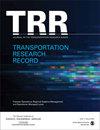Simulation Study of Pedestrians Evacuation Considering Aggressive Behavior
IF 1.8
4区 工程技术
Q3 ENGINEERING, CIVIL
引用次数: 0
Abstract
Conflict during an evacuation may turn into aggressive behavior and create problems for evacuation. To study the influence of attack behaviors such as pushing and shoving on evacuation and the evacuation law, an extended cellular automata model is developed in this paper. In the model, pedestrian movement is influenced by static, dynamic, and attack floor fields. In addition, pedestrian vision is influenced by the direction and location of movement of surrounding pedestrians, and pedestrians adopt different coping strategies for attacks: avoidance detour, or imitation. Attacker movement and aggressive behavior are also studied. Numerical simulations are conducted to discuss the pedestrian evacuation problem under attack behavior. The effects of the evacuation process, attack field sensitivity coefficient, location of fallen pedestrians, pedestrian density, number of initial attackers, initial attacker location, and pedestrian imitation ratio on evacuation time and number of fallen pedestrians are analyzed. The simulation results show that an appropriate increase in the impact of the attack field can slow down the congestion, that is, the evacuation time is the fastest at k A = 0.5. The evacuation time is faster when the room is full of normal pedestrians or full of attacking pedestrians. The number of casualty pairs is high when the initial position of the attacker is in the middle of the inner side of the room. The results of the study can provide recommendations and guidance for the formulation of evacuation strategies for pushing and shoving type attacks and reducing casualties.考虑攻击行为的行人疏散仿真研究
疏散过程中的冲突可能会转变为攻击行为,给疏散带来麻烦。为了研究推、推等攻击行为对疏散的影响及疏散规律,本文建立了扩展元胞自动机模型。在模型中,行人的运动受到静态、动态和攻击地板场的影响。此外,行人的视觉受到周围行人运动方向和位置的影响,行人对攻击采取不同的应对策略:回避绕行或模仿。攻击者的运动和攻击行为也进行了研究。对攻击行为下的行人疏散问题进行了数值模拟。分析了疏散过程、攻击场敏感系数、倒下行人位置、行人密度、初始攻击者数量、初始攻击者位置、行人模仿比等因素对疏散时间和倒下行人数量的影响。仿真结果表明,适当增加攻击场的影响可以减缓拥塞,即在k A = 0.5时疏散时间最快。当房间里满是正常行人或满是攻击行人时,疏散时间更快。当攻击者的初始位置在房间内侧的中间时,伤亡人数会很高。研究结果可为推搡型袭击的疏散策略制定提供建议和指导,减少人员伤亡。
本文章由计算机程序翻译,如有差异,请以英文原文为准。
求助全文
约1分钟内获得全文
求助全文
来源期刊

Transportation Research Record
工程技术-工程:土木
CiteScore
3.20
自引率
11.80%
发文量
918
审稿时长
4.2 months
期刊介绍:
Transportation Research Record: Journal of the Transportation Research Board is one of the most cited and prolific transportation journals in the world, offering unparalleled depth and breadth in the coverage of transportation-related topics. The TRR publishes approximately 70 issues annually of outstanding, peer-reviewed papers presenting research findings in policy, planning, administration, economics and financing, operations, construction, design, maintenance, safety, and more, for all modes of transportation. This site provides electronic access to a full compilation of papers since the 1996 series.
 求助内容:
求助内容: 应助结果提醒方式:
应助结果提醒方式:


